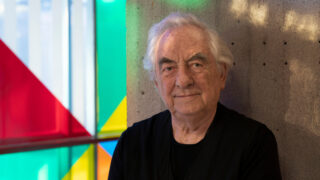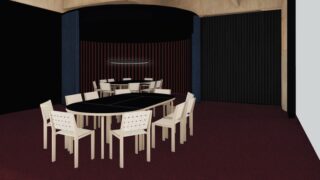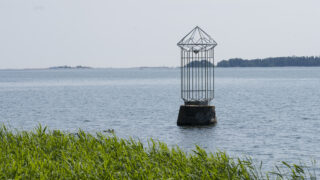Espoo Museum of Modern Art
Daniel Buren: “I think it’s great how museums are prepared to take a risk presenting my works, because they can never know what to expect.”


EMMA's Executive Director Pilvi Kalhama interviewed the legendary Daniel Buren during his visit to EMMA on September 9, 2020. Buren shares his thoughts on museums, his art – which he prefers not to call ‘art’ – and the future of globalization in our post-pandemic reality.
The French artist Daniel Buren (b. 1938) is a contemporary art visionary who has challenged prevailing notions of art and pushed the boundaries of art institutions many times throughout his extensive career. He is acclaimed for his spatial, ephemeral in situ pieces that engage the unique features of the site.
Buren’s new exhibition at EMMA, Going for a Walk in a Zigzag, highlights an immersive piece created especially for EMMA, Les Paravents (Folding Screens), which takes its cue from the museum’s architecture.
I Institutional critique
Pilvi Kalhama: How have your views on the artworld and museums changed throughout your long career? How do you perceive the role of contemporary art museums today?
Daniel Buren: The museum establishment began to change in the late 1970s. We saw something unprecedented in art history. Suddenly, in the early 1980s, museums were everywhere, they began popping up like mushrooms. Today there are thousands and thousands of museums dedicated exclusively to visual art. Museums have reinvented themselves and redefined their presence.
My opinion about museums has changed just like museums themselves have changed. Their hegemonic status has crumbled. Museums are no longer the sole authority deciding on our behalf what is good or bad. But this loss of authority can also be viewed from a contrary perspective, as something not altogether desirable.
It’s interesting how museums are much, much more open these days. People visit them, and they offer a channel of self-expression to a growing number of practitioners. But then again, in losing their authority, they have also lost their power to point the way for future generations – and this was an important, constructive, and pioneering role performed by museums for a long time.
It’s important to understand that my earlier writings critiquing museums concerned a particular period in history. Not all of it is necessarily relevant today.
PK: What would you change – if you could – about museums today? What problems exist from an artist’s perspective in your opinion?
DB: The way museums have opened up has definitely been a step in a positive direction. But I’m concerned about the problematic way that money and economics have infiltrated the artworld. Many European museums, both large and small, are city-funded public institutions. But even in the public sector, there’s a widespread belief that art should be funded privately. This has led to a steady decline in art’s public funding both at the national and local level. This is how we have ended up in the present situation that is best summed up by the word ‘confusion’, where private ‘fanatical’ money is exerting a growing influence in the museum field.
For instance, you’ll see museums hosting an exhibition just because some private sponsor has the money and motivation to finance a certain show. This ultimately destroys the whole idea of what museums are about, because in having lost the power to decide over their own content, it means they’ve lost their last shred of authority. When this happens, a museum is no longer a pedagogical place. And the vicious circle goes on: the museum agrees to host an exhibition because it brings in external funding, but meanwhile it loses another chunk of public funding. This trend should be viewed with concern.
II Artists and museums – power of influence
PK: Your work and career have exerted a major impact on how museums have evolved and opened up over the past few decades. How much power do you think art and artists have to influence museums nowadays?
DB: Sometimes I have been questioned for critiquing the institution that employs me. But I’ve always felt that the people who work in museums are very similar in mentality to artists. By collaborating with museums, I have had the opportunity to influence them from the inside. Many museums have been interested in this idea, and they have been keen to see where our collaboration might lead.
Before the 1960s generation, artists didn’t want to change museums. But if you think about Joseph Beuys and my generation of artists, we truly achieved a change. Looking back, I can recall many interesting anecdotes. Once, when I was planning my first museum exhibition, the museum director wanted to add one of my works to their collection. I proposed a piece, but it was rejected by the museum committee, even though it was the director who suggested the acquisition in the first place. Their objections concerned the nature of the work. I proposed a piece that is never the same twice – it would have been completely different every time it was displayed. The museum decided this was unfeasible because the work would have been impossible to categorize in its data management system and processes. They said it couldn’t be reinvented every time. Later on, I created this very piece in collaboration with the Centre Pompidou.
PK: But today, decades later, museums are prepared to also collect conceptual pieces.
DB: Yes, and I think it’s great how museums these days are prepared to take a risk presenting my work, because they can never know what to expect. To tell the truth, even I don’t know what to expect. With most of my projects, I have no idea what shape the work will take. The open-minded approach we are seeing among museum directors, curators and other personnel signifies an incredibly big change. And the change I have pushed for in the museum establishment is not just a theoretical one – it has addressed real practices and specific situations.
The museum scene has witnessed a radical transition if you think about everything that has happened since 1971 or 1972. The change is still ongoing, and I can’t even imagine what direction it might take in the future. I’m pessimistic in many respects, but it’s possible that my worst fears won’t eventuate. The greatest danger, as I see it, at least in the case of smaller museums, concerns the financial mechanisms I described earlier. If this trend continues, as it appears to be, it will lead to certain museums closing their doors. It must be understood that not all museums are successful, but this doesn’t mean that they don’t perform an important function in society. Museums exist not only for artists, but above all for their many audiences.
III The purpose of art
PK: What, for you, is the fundamental meaning and purpose of art?
DB: Personally, I don’t have a definition for the word ‘art’. I doubt that you’ll ever hear me using that word. I avoid it as a prefix in contexts like ‘artwork’ or ‘art-blah-blah-blah’ or the like. I prefer to stick with the simple word ‘work’. It’s a mundane, inexplicit word. Even if I see or read about an artist who proposes an interesting definition of ‘art’, I still don’t know what its meaning is. Using the word ‘art’ is like sticking a hat on something unknown.
If you say: “This is an artwork”, I could reply, “Okay, in relation to what?” The word ‘art’ might equally refer to cuisine, shoemaking, acrobatics, singing or anything. The problem is that when we speak about art, nobody asks or questions what we’re really talking about. Early in my career, I wrote about art without ever using the term just to avoid having to explain it. I deleted the whole word from my vocabulary. ‘Art’ is simply too broad. Even today, nobody questions what it really means.
So, returning to your question, I cannot say what the fundamental purpose of my work is. Although I’m getting older, I can’t ever see myself reaching a final destination. Perhaps I wouldn’t pair the words ‘fundamental’ and ‘meaning’. I prefer to speak of a ‘continuum’. One day, I’ll die, and it will end.
PK: Still, many are bound to assume that you must ‘believe in art’ because you have such am amazing career behind you and you are still working on your ‘continuum’. Do you believe in art as a medium?
DB: What matters most is the result, that the work is presented and seen. My works wish to be seen. In being seen, they challenge something within us, or not, as the case may be. A work that is never seen by anyone besides its maker is a work that does not exist. A work begins to exist only when someone, even just one person, sees it. It is then that the work engages in a relationship with the world, surrendering itself to questioning and critique. It exists by virtue of being seen. That’s why one of my key principles is that my work – being site-specific – is immediately on display the moment I finish it.
PK: In certain respects your medium is painting, but your works aren’t paintings. Do you see yourself as deconstructing or reinventing the medium of painting?
DB: Physically, yes, I stopped painting, but I regard painting as a very special medium. Not everything is possible in painting. As I see it, all the Great Paintings were already done centuries ago. I haven’t tried to run away from painting, but nor have I tried to pursue my creative ambitions within the medium’s boundaries, because painting has such a venerable history. I have deemed it wiser to choose a different path.
PK: Do you think the pandemic has changed or will somehow change art or its institutions? Has it impacted your work mentally? What challenges has the crisis created for artists?
DB: The pandemic has paradoxically shown us that we’re all connected, in both a positive and negative sense – to each other, to nature and to life in general. Half the work and processes that were going on around the planet were brought to a standstill by the crisis. Economists could never have predicted something that could bring everything around the world to such a crippling halt. It could upend the whole global economy, which has been expanding at an accelerating pace – too quickly and too forcefully – for the past 20 years.
PK: Do you mean the very notion of globalization is changing permanently?
DB: I believe so. This applies especially to the accelerated phase we have been living in. But in my opinion, globalism is at the core of humanism. We’ve just gone too far too fast. Hopefully we haven’t overstepped the line.
Edited by Arja Miller.
Translation by Silja Kudel.


